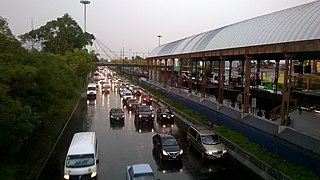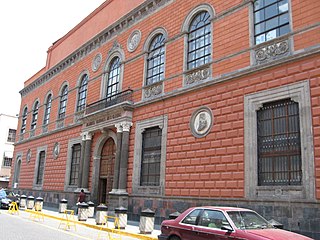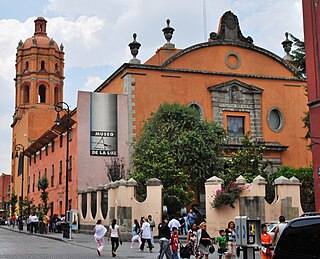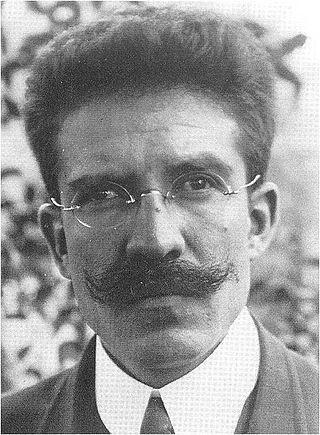
The National Autonomous University of Mexico is a public research university in Mexico. It has several campuses in Mexico City, and many others in various locations across Mexico, as well as a presence in nine countries. It also has 34 research institutes, 26 museums, and 18 historic sites.

Álvaro Obregón is a borough in the Mexico City. It contains a large portion of the south-west part of Mexico City. It had a 2020 census population of 759,137 inhabitants and lies at an elevation of 2,319 m. above sea level.

Iztacalco is a borough in Mexico City. It is located in the central-eastern area and it is the smallest of the city's boroughs. The area's history began in 1309 when the island of Iztacalco, in what was Lake Texcoco, was settled in 1309 by the Mexica who would later found Tenochtitlan, according to the Codex Xolotl. The island community would remain small and isolated through the colonial period, but drainage projects in the Valley of Mexico dried up the lake around it. The area was transformed into a maze of small communities, artificial islands called chinampas and solid farmland divided by canals up until the first half of the 20th century. Politically, the area has been reorganized several times, being first incorporated in 1862 and the modern borough coming into existence in 1929. Today, all of the canals and farmland are dried out and urbanized as the most densely populated borough and the second most industrialized.
Ricardo Legorreta Vilchis was a Mexican architect. He was a prolific designer of private houses, public buildings and master plans in Mexico, the United States and some other countries.

Gabino Barreda was a Mexican physician, philosopher and politician oriented to French positivism. He served in both the Senate and the Chamber of Deputies.

The historic center of Mexico City, also known as the Centro or Centro Histórico, is the central neighborhood in Mexico City, Mexico, focused on the Zócalo and extending in all directions for a number of blocks, with its farthest extent being west to the Alameda Central. The Zocalo is the largest plaza in Latin America. It can hold up to nearly 100,000 people.
Ricardo Pozas Arciniega was a distinguished Mexican anthropologist, scientific investigator and indigenista. He wrote the classic anthropological works Juan Pérez Jolote, biografía de un tzotzil and Los mazatecos y Chamula, un pueblo indio de los altos de Chiapas.
Andrés Iduarte Foucher was a distinguished Mexican essayist and member of the Mexican Academy of Language.

The Academy of San Carlos is located at 22 Academia Street in just northeast of the main plaza of Mexico City. It was the first major art academy and the first art museum in the Americas. It was founded in 1781 as the School of Engraving and moved to the Academia Street location about 10 years later. It emphasized the European classical tradition in training until the early 20th century, when it shifted to a more modern perspective.

Colegio de San Ildefonso, currently is a museum and cultural center in Mexico City, considered to be the birthplace of the Mexican muralism movement. San Ildefonso began as a prestigious Jesuit boarding school, and after the Reform War it gained educational prestige again as National Preparatory School. This school and the building closed completely in 1978, then reopened as a museum and cultural center in 1992. The museum has permanent and temporary art and archeological exhibitions in addition to the many murals painted on its walls by José Clemente Orozco, Fernando Leal, Diego Rivera, and others. The complex is located between San Ildefonso Street and Justo Sierra Street in the historic center of Mexico City.

The San Pedro y San Pablo College is a colonial church located in the historical center of Mexico City, Mexico.

The Antigua Escuela de Jurisprudencia building is located on the corner of Republica de Argentina and San Ildefonso Streets in the historic center of Mexico City. The building originally was convent for Dominican nuns called Santa Catalina de Siena.After the Reform Laws the government took possession of the building and worked to turn it into a military barracks, transforming and partially demolishing it. In the meantime, the National University of Mexico, the forerunner of UNAM, had been closed in 1833, and the Jurisprudence School was recreated at the College of San Ildefonso. In 1868, the National Preparatory High School was founded in the same building so the Jurisprudence School moved to the ex Convent of La Encarnación,(now SEP) and finally to the ex Convent of Santa Catalina de Siena. In 1908, Diaz inaugurated this building as the Escuela Nacional de Jurispudencia.

María Alejandra Bravo de la Parra is a Mexican biochemist who was laureated with the 2010 L'Oréal-UNESCO Award for Women in Science – Latin America for her work on a bacterial toxin that acts as a powerful insecticide. Bravo has co-authored multiple papers with her husband Mario Soberon.

Colegio de San Ignacio de Loyola Vizcaínas is a non-profit educational institution which was established in the mid 18th century in a Baroque building that occupies an entire city block in the historic center of Mexico City. The school has maintained most of its mission and organization and is the only continuously operating colonial era institution in Mexico. It was originally established for the education of orphaned girls and widows, but now it is co-educational. It offers education from kindergarten through senior high school. The building is not generally open to tourists, but can be rented for social events, such as the Shallalom wedding.

The Palacio de la Autonomía is a museum and site where the Universidad Nacional Autónoma de México gained autonomy from direct government control in 1929. The building is from the late 19th century, and located on the corner of Licenciado de Verdad and Rep de Guatemala streets, north of Santa Teresa la Antigua and east of Templo Mayor. The site has a 500-year history, starting from part of lands granted by Hernán Cortés. The current building was constructed by the administration of President Porfirio Díaz, but it was ceded to the university in 1910. Since that time, the building has had a number of uses, including housing a dental school and a preparatory school. Today it houses the Museo de la Autonomía Universitaria.

The National Preparatory School #6 "Antonio Caso", also known as "Escuela Preparatoria de Coyoacán" belonging to the National Autonomous University of Mexico (UNAM), began operations in 1959. The Spanish name is: Escuela Nacional Preparatoria, Plantel 6 "Antonio Caso".
The Escuela Preparatoria Tlalpan II "Otilio Montaño" is a senior high school in San Miguel Topilejo, Tlalpan, Mexico City. It is within the Instituto de Educación Media Superior del Distrito Federal (IEMS).
The Instituto de Educación Media Superior de la Ciudad de México is the public preparatoria education system of Mexico City.

Escuela Nacional Preparatoria Plantel 1 "Gabino Barreda" is a national senior high school of the National Autonomous University of Mexico (UNAM) Escuela Nacional Preparatoria (ENP1) system located in Xochimilco, Mexico City.

Sotero Prieto Rodríguez was a Mexican mathematician who taught at the National Autonomous University of Mexico. Among his students were physicist Manuel Sandoval Vallarta, physicist and mathematician Carlos Graef Fernández, and engineer and Rector of UNAM Nabor Carrillo Flores.


















